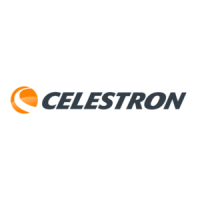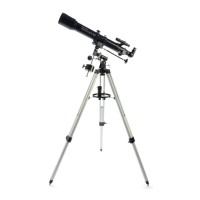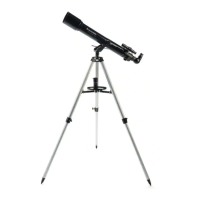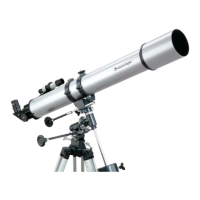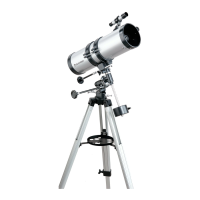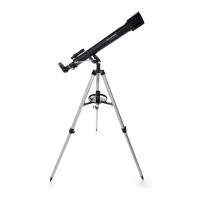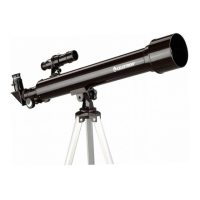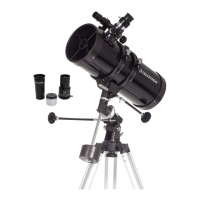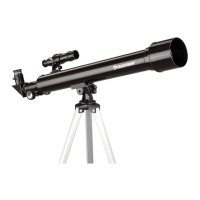Do you have a question about the Celestron PowerSeeker 76AZ # 21044 and is the answer not in the manual?
Important safety precautions to prevent eye damage and equipment harm.
Step-by-step instructions for assembling the telescope tripod and accessory tray.
Instructions on how to point and move the telescope using the mount's controls.
Steps to install the diagonal and eyepiece for 60AZ refractor models.
Steps to install the diagonal and eyepiece for 50AZ refractor models.
How to insert and secure eyepieces into the focuser tube of Newtonian telescopes.
Instructions for attaching and using the 3x Barlow lens to increase magnification.
Guide for installing and using the 1.5x erecting eyepiece for terrestrial viewing.
Steps to mount the finderscope onto the telescope optical tube.
Procedure to align the finderscope with the main telescope for accurate aiming.
How the eyepiece and diagonal affect image orientation (upright, inverted, reversed).
How to adjust the focus knob to achieve a clear image of celestial objects.
Formula and method to calculate telescope magnification based on eyepieces.
How to calculate the true angular field of view for accurate object location.
Essential tips for optimal viewing conditions and avoiding common pitfalls.
Explanation of Right Ascension (RA) and Declination (DEC) for locating sky objects.
Tips for observing the Moon, including best phases and contrast enhancement.
Guidance on observing planets like Venus, Mars, Jupiter, and Saturn.
Precautions and methods for safely observing the Sun and sunspots.
Method for locating deep-sky objects by navigating between bright stars.
Step-by-step guide to finding the Andromeda Galaxy using star hopping.
Guide to finding the Ring Nebula using star hopping and averted vision.
Atmospheric clarity affected by clouds, moisture, and particles.
Effect of Moon, aurorae, and light pollution on observing.
Atmospheric stability affecting image detail and sharpness.
Beginner's guide to imaging celestial objects with a camera attached.
Using specialized cameras for enhanced planetary and lunar imaging.
Advanced techniques for capturing deep-sky images with CCD cameras.
Using the telescope as a telephoto lens for land-based photography.
Proper methods for cleaning telescope lenses and mirrors to avoid damage.
How to align the optics of Newtonian telescopes for best image quality.
Procedure for adjusting the secondary mirror for proper alignment.
Adjusting the primary mirror screws for concentric mirror reflections.
Using stars to fine-tune primary mirror alignment for optical accuracy.
Celestial maps for learning constellations and locating astronomical objects.
Economically priced eyepieces offering sharp views for 60AZ & 76AZ models.
Barlow lens that doubles magnification for eyepieces, for 60AZ & 76AZ.
Filter to reduce lunar brightness and improve contrast for observation.
Filter to enhance deep sky views by reducing light pollution.
Red LED flashlight designed to preserve night vision during observation.
Accessory for easily accomplishing Newtonian telescope collimation.
Collimation eyepiece ideal for precise alignment of Newtonian telescopes.
Universal adapter for mounting digital cameras for afocal photography.
Adapter to attach 35mm SLR cameras to telescope focusers for photography.
| Focal Length | 700 mm |
|---|---|
| Mount Type | Altazimuth |
| Eyepieces | 20 mm (35x), 4 mm (175x) |
| Finderscope | 5x24 |
| Tripod | Aluminum |
| Highest Useful Magnification | 180x |
| Optical Design | Reflector |
| Type | Reflector |
| Aperture | 76 mm |
| Focal Ratio | 9.2 |
